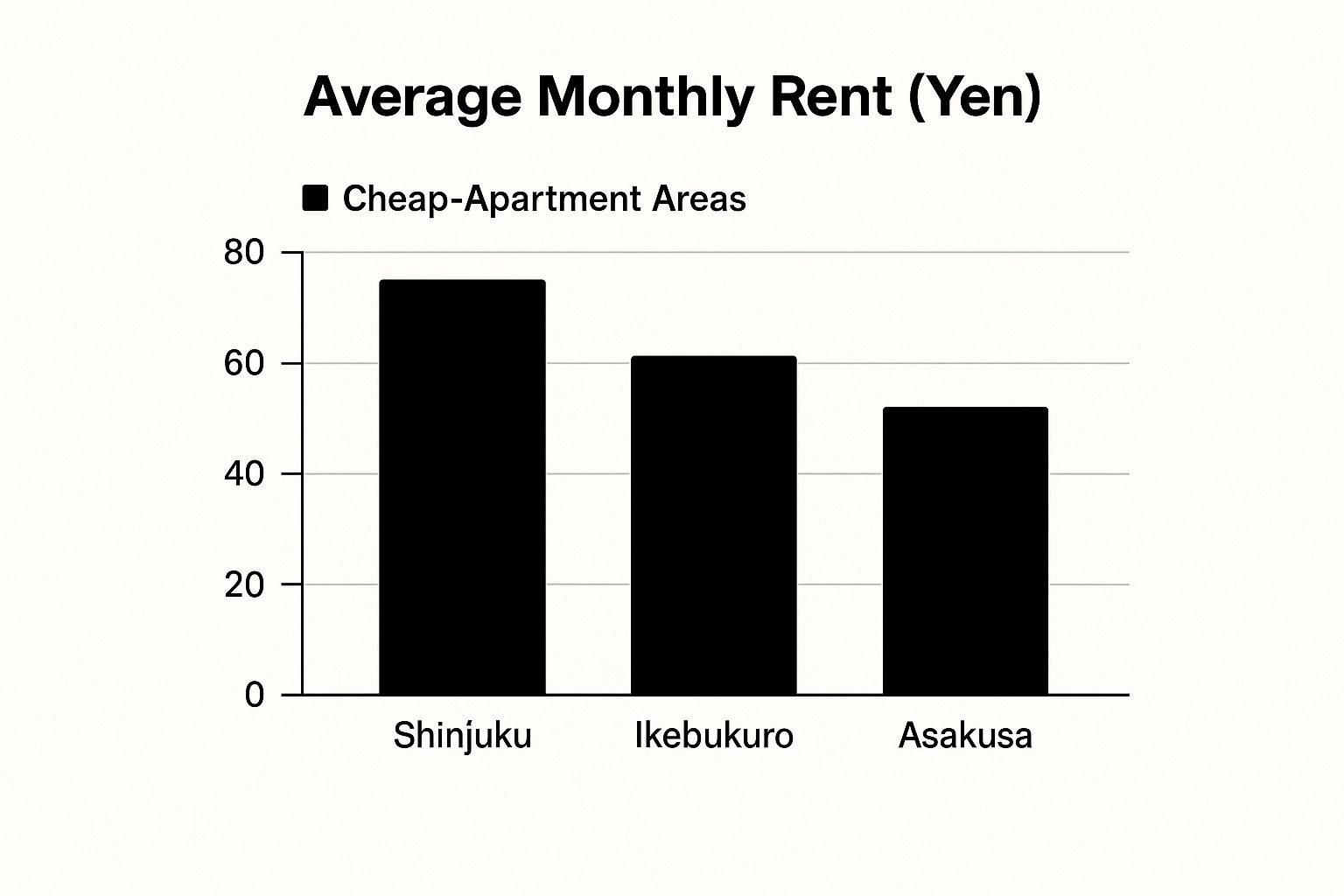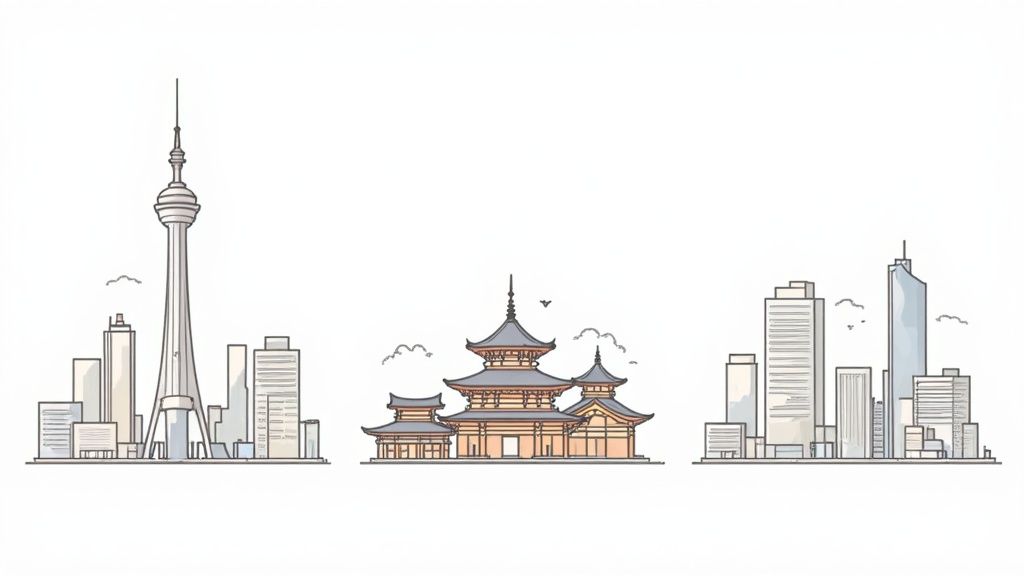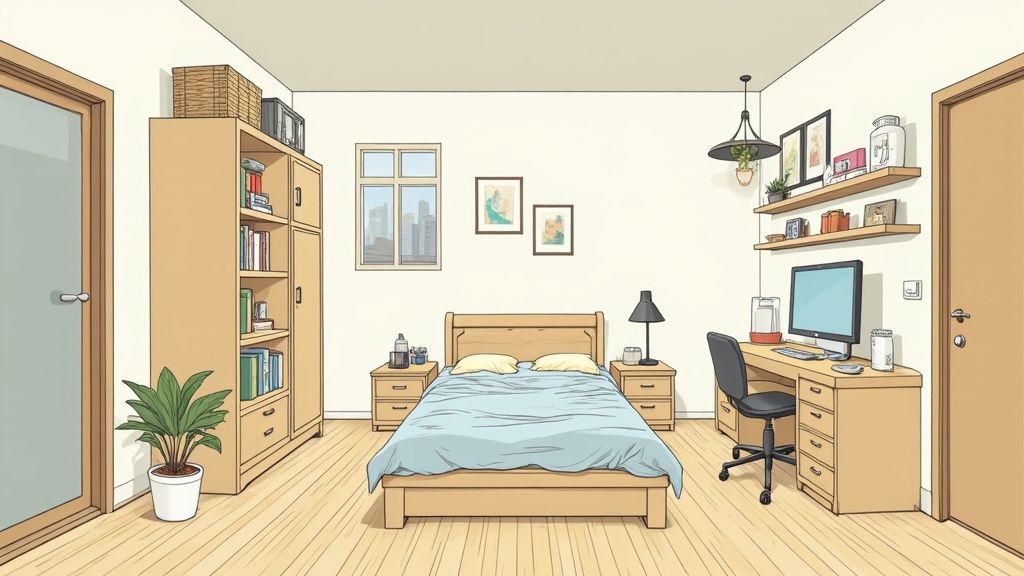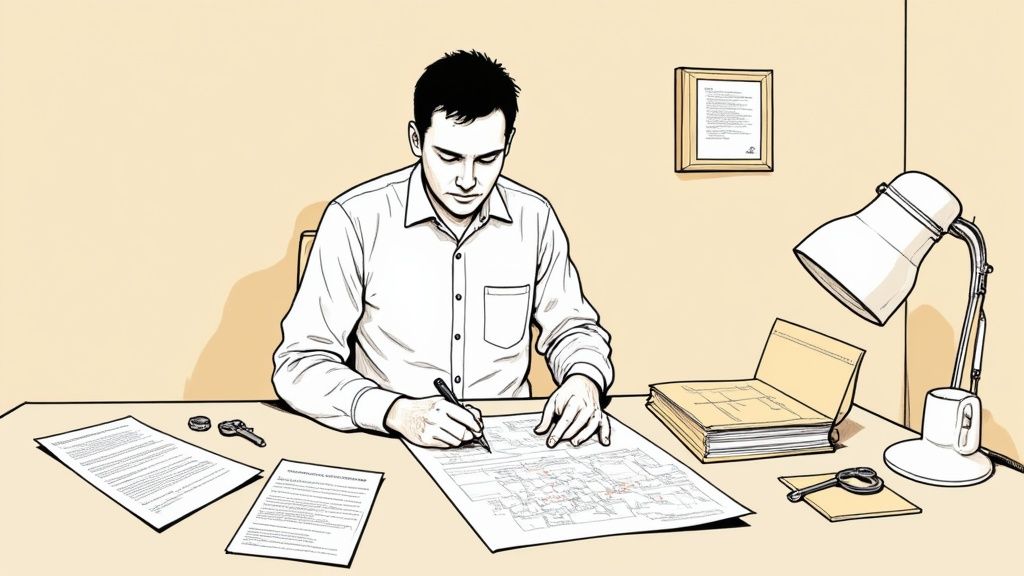Find Your Ideal Cheap Tokyo Apartment Today
Looking for a cheap Tokyo apartment? Discover budget-friendly neighborhoods and tips to find affordable rentals easily. Click for expert advice!
Posted by

So, you're on the hunt for a cheap Tokyo apartment. The first thing to get your head around is that the number on the listing—the monthly rent—is only part of the story. The real gut-punch for most newcomers is the mountain of upfront fees you have to pay.
We’re talking about an initial outlay that can easily add up to three to five months' rent. It’s a huge financial hurdle that catches a lot of people off guard.
Understanding the Real Cost of Renting in Tokyo
Before you even dream about what neighborhood you want to live in, you need to get real about the total cost. In many Western countries, you might just need the first month's rent and a security deposit. Easy enough. Japan, however, has a unique rental system with a whole list of one-time payments that balloon your move-in costs.
These aren't optional add-ons; they're standard practice. If you don't budget for them from the get-go, your apartment search will stall before it even begins. This is why nailing down a realistic budget is step zero—and it has to cover way more than just that recurring monthly payment.
The Breakdown of Upfront Fees
Once you start looking at places, your real estate agent will hand you a cost estimate sheet. Don't be surprised when you see a bunch of items you've never heard of. Most of these fees are calculated based on a multiple of the monthly rent, which at least makes estimating your total costs fairly straightforward.
You're almost certain to run into these:
- Security Deposit (敷金, shikikin): This is pretty standard. It’s usually one month's rent and is held by the landlord to cover any damages. You should get most of it back if you leave the place in good shape.
- Key Money (礼金, reikin): Here's a uniquely Japanese concept. It’s a non-refundable "gift" to the landlord, typically one month's rent. While it's slowly becoming less common, you'll still see it on plenty of newer or highly desirable properties.
- Agency Commission (仲介手数料, chūkai tesūryō): This is the fee you pay the real estate agent for their hard work. It's almost always one month's rent plus tax.
- Guarantor Company Fee (保証会社利用料, hoshō-gaisha riyō-ryō): Most landlords require a Japanese guarantor, which is tough for foreigners to find. Instead, you'll pay a guarantor company to back your application. This usually costs between 50% to 100% of one month's rent.
The Rule of Thumb: Plan on having at least four times your target monthly rent saved up and ready to go. So, if you're eyeing apartments around ¥70,000 a month, you'll need a war chest of about ¥280,000 just to get the keys.
This chart gives you a quick look at the average monthly rent for a small apartment in a few popular and relatively affordable Tokyo neighborhoods.

As you can see, even within the "cheaper" districts, location matters. A spot in Asakusa will be a lot kinder to your wallet than one in a major hub like Shinjuku. Understanding these differences is key to setting a realistic budget.
If you want more context on what to expect when you get here, our guide on what life in Japan as a foreigner is really like is a great place to start.
Typical Initial Move-In Costs for a Tokyo Apartment
To make it crystal clear, here’s an estimated breakdown of the one-time fees you'll face when signing a lease. These costs are almost always calculated as a multiple of your monthly rent.
| Fee Type | Typical Cost (Multiple of Monthly Rent) | Purpose |
|---|---|---|
| First Month's Rent | 1x Rent | Paid in advance for your first month of occupancy. |
| Security Deposit (敷金) | 1x Rent | A refundable deposit to cover potential damages. |
| Key Money (礼金) | 0-1x Rent | A non-refundable "gift" to the landlord. |
| Agency Commission (仲介手数料) | 1x Rent (+ tax) | Fee paid to the real estate agency for their service. |
| Guarantor Fee (保証会社利用料) | 0.5-1x Rent | Payment to a company that guarantees your lease. |
| Lock Change Fee (鍵交換代) | ¥15,000 - ¥25,000 | A mandatory fee to change the locks for security. |
| Insurance (火災保険料) | ¥15,000 - ¥20,000 | Mandatory fire and renter's insurance for 2 years. |
When you add it all up, the total can be a bit of a shock. But knowing this from the start puts you in a much stronger position to find an apartment you can actually afford without any last-minute financial panic.
Finding Affordable Neighborhoods That Feel Like Home

Where you live in Tokyo isn't just an address; it's the backdrop to your daily life and the single biggest factor affecting your budget. Everyone has that picture-perfect image of living near the Shibuya Scramble, but let's be real—the rent in those central wards makes finding a cheap Tokyo apartment an uphill battle.
The secret to affordable living here is to look just a little further out from the glittering city center. This doesn't mean you'll be exiled to the suburbs, either. Thanks to Tokyo's ridiculously efficient train system, neighborhoods that feel miles away are often just a short, direct ride from all the action, offering a more local, relaxed vibe without the sky-high price tag.
Look Beyond the Yamanote Line
Think of the JR Yamanote Line as Tokyo's inner circle. Anything inside or directly on this loop is prime real estate, and the prices reflect that. The real value is found by expanding your search to areas along other major train lines that feed directly into hubs like Shinjuku, Shibuya, or Tokyo Station. These are the neighborhoods where you'll discover the hidden gems.
Here are a few budget-friendly wards to get you started:
- Nerima-ku: Tucked away in the northwest, Nerima is known for its quiet, residential feel and abundance of green spaces. It’s got a bit of a suburban charm but offers fantastic, direct train access to major hubs like Ikebukuro and Shinjuku.
- Adachi-ku: Head north and you'll find Adachi, one of the most affordable wards in the city. It’s a genuine, down-to-earth area with a great community feel and is well-connected by the Chiyoda and Hibiya subway lines.
- Katsushika-ku: Over to the east, Katsushika feels like a step back in time. With its traditional shopping streets (shotengai) and historic temples, it offers a slower pace of life and significantly lower rents.
The Commute-versus-Cost Trade-Off
Let’s put this into perspective. You might spot a modern 1K apartment (a studio with a separate kitchen) in the heart of Shibuya for ¥110,000 a month. Shift your search to Nerima, just a 20-minute direct train ride away, and you could easily find a similar, if not larger, apartment for around ¥75,000.
That simple compromise on your commute saves you ¥420,000 (about $2,800 USD) over a single year. That’s more than enough to cover all your hefty initial moving fees or pay for a couple of nice trips around Japan.
The city is starting to recognize the squeeze on renters. The Tokyo Metropolitan Government has even earmarked 10 billion yen for a new policy aiming to cap rents on certain housing at around 80% of market rates. It's worth reading up on Tokyo's affordable housing policy to see how new initiatives might help your search.
Consider Just Outside the 23 Wards
For the absolute best deals, you have to be willing to look just across the border. Neighboring prefectures like Saitama, Chiba, and Kanagawa have cities with significantly cheaper apartments, many of which are on train lines that offer shockingly quick and direct commutes into central Tokyo.
I'm talking about places like:
- Kawaguchi, Saitama: It’s literally right on the border, making for a super quick trip into northern Tokyo.
- Ichikawa, Chiba: Hop on the Sobu Line here and you’ll be at Tokyo Station in no time.
- Kawasaki, Kanagawa: A huge city in its own right, perfectly sandwiched between Tokyo and Yokohama.
A little flexibility on your location opens up a massive range of options. It's what makes living in one of the world's most incredible cities not just a dream, but an affordable reality.
Time to Start the Hunt: Real Strategies for Finding Your Place
https://www.youtube.com/embed/BZqWXh9K2jA
Alright, you've crunched the numbers on your budget and have a shortlist of neighborhoods you'd love to live in. Now for the fun part: actually finding that perfect, affordable Tokyo apartment. This is where the rubber meets the road, and you'll quickly discover that Japanese real estate has its own unique language and quirks. Learning to navigate them is the secret to uncovering a real gem.
Your best friends in this process will be the big online real estate portals and the agents who manage the listings. While it might seem like there are dozens of websites, most of them are pulling from the same handful of national databases. The real magic isn't which site you use, but how you use it—specifically, how you filter your searches and talk to the agents.
Learning the Lingo of Japanese Listings
Jumping into Japanese apartment listings for the first time can feel a little disorienting. They're packed with shorthand and specific terms for layouts and fees that you just don't see elsewhere. Getting a handle on these will make your search a thousand times easier.
Here are the absolute essentials you'll see on nearly every listing:
- 1K (One Room, Kitchen): Think of this as a studio, but with a wall separating the small kitchen area from your main living and sleeping space.
- 1DK (One Room, Dining, Kitchen): A step up from the 1K. The kitchen area is more spacious, giving you enough room to pop in a small dining table.
- 1LDK (One Room, Living, Dining, Kitchen): This is the layout many single folks and couples aim for. It gives you a proper separate bedroom plus a combined living, dining, and kitchen space.
You'll also see those initial fees we covered earlier, but now in their proper Japanese terms: shikikin (敷金) is your security deposit, and reikin (礼金) is the infamous "key money." Finding a place advertised with "reikin zero" is a major victory for your wallet.
Master the Search Filters to Uncover Hidden Deals
The real power of any apartment-hunting website is in its search filters. This is where you can get clever and find listings that others might overlook. Don't just plug in your maximum rent and call it a day; the key is to think strategically about what you're willing to compromise on.
So many people make the mistake of being way too strict with their search. If you can be flexible on just one or two things—like how far you're willing to walk from the station or the building's age—you can unlock a whole new tier of cheaper apartments.
Try playing around with these filters to see what pops up:
- Distance from Station: Everyone wants that 5-minute walk. That’s why you should try setting your search to a 10- or even 15-minute walk instead. Rents often take a noticeable dive once you get past that 10-minute mark.
- Building Age (築年数, chikunensuu): Don't automatically write off older buildings. A well-kept apartment from the 90s can be perfectly comfortable and significantly cheaper than a brand-new place. Keep an eye out for the magic words risofoomu-zumi (リフォーム済み), which means it's been recently renovated.
- Floor Level: Apartments on the ground floor are usually a bit cheaper. They might get less sunlight, but sometimes they come with a tiny private garden space, which is a huge plus. It’s an easy trade-off to save a few thousand yen a month.
Finding the right spot is all about experimenting with these variables. For an even deeper dive, check out our complete guide on how to find a cheap home in Japan for more pro tips.
Navigating Apartment Viewings and Applications

You’ve spent hours scrolling through listings and finally have a shortlist of promising apartments. Now for the crucial reality check: the viewing, known as a naiken (内見) in Japan.
This is your only real chance to spot the deal-breakers that those perfect, wide-angle photos are designed to hide. Getting this step right is everything, especially when you're hunting for a cheap Tokyo apartment that won't turn into a nightmare down the road.
Tokyo’s rental market is incredibly fast-paced. Don't be surprised if you're shown a place while the current tenant is still living there or just a few days after they've moved out. You need to go in with a plan and a critical eye. Don’t just wander through—you’re there to inspect, not just admire.
Your Essential Viewing Checklist
It's so easy to be charmed by a great view or a shiny new kitchen and completely miss the glaring red flags. To keep yourself grounded, bring a checklist (even a mental one) of things to actively investigate. These are the details that separate a true bargain from a future headache.
- Water Pressure & Drainage: This is a big one. Turn on every single faucet—kitchen, bathroom sink, and especially the shower. Weak water pressure is a classic issue in older buildings, and a slow-draining sink could point to deeper plumbing problems.
- Noise Levels: Pause for a moment and just listen. Seriously. Can you hear the elevator dinging? Your upstairs neighbor’s footsteps? Traffic from the nearby road? What seems like a minor annoyance now can drive you crazy after a few weeks.
- Sunlight & Airflow: Natural light is gold in Tokyo. Check which direction the main windows face; a south-facing apartment is a huge plus, especially during the darker winter months. Open the windows. You're checking for a cross-breeze and making sure a neighboring building doesn't block all your sun.
- Storage Space: Japanese apartments are notoriously compact. Open every closet, cabinet, and storage space you see. Will your stuff actually fit, or will you be tripping over boxes for the foreseeable future?
Remember, the agent's goal is to rent the apartment. Your job is to be the skeptic. Ask direct questions about the building's age, when major repairs were last done, and what the neighbors are like. A good agent will have the answers, but you have to be the one to ask.
Preparing for the Application Process
Found "the one"? Amazing! But now you have to move fast. In Tokyo's red-hot market, landlords simply won't wait around. The application and screening process is notoriously thorough, so being prepared gives you a massive advantage.
As a foreigner, you will almost certainly be required to use a guarantor company, or hoshou-gaisha (保証会社). This company essentially co-signs your lease, guaranteeing the landlord gets paid, in exchange for a fee.
Both the guarantor company and the landlord will be scrutinizing your application to make sure you're a stable and reliable tenant. The competition is real. The residential property price index in the Tokyo Metropolitan area shot up by 8.14% year-over-year, and in Tokyo proper, it was an even steeper 10.7% jump. You can learn more about Japan's property market trends to get a sense of what you're up against.
To give yourself the best shot at getting approved, have this paperwork scanned and ready to go before you even start viewing places:
- Residence Card (Zairyu Card): This is non-negotiable. It’s your proof of legal residency.
- Proof of Income: Typically, this means a Certificate of Employment (zaishoku shoumeisho) from your company and your most recent pay stubs. If you’re just starting a new job, an official offer letter spelling out your salary will usually work.
- Japanese Bank Account: While you might not need it for the initial form, having a local bank account shows you’re established and makes you look like a much more stable candidate.
- Emergency Contact in Japan: This needs to be someone living in Japan—a friend, a boss, a colleague. They aren't on the hook financially, but they must be reachable.
Showing up with all your documents in order right after a viewing signals that you're a serious, organized applicant. In a competitive market, that little bit of preparation can be the very thing that puts you ahead of the pack and helps you lock down your new home.
Don't Sign Yet! How to Finalize Your Lease and Avoid Nasty Surprises
So, you got the call—your application was approved. Congratulations! That's a huge hurdle cleared, but take a deep breath before you grab a pen. This final stage is where you lock in the terms of your tenancy, and a little due diligence now can save you a world of headaches (and money) down the line.
The document in front of you is the chintai-shaku keiyaku-sho (賃貸借契約書), your official rental contract. It’s a dense, legally binding agreement. Even if they've provided an English version, it's often a clunky, direct translation loaded with jargon. This is especially true when you’re hunting for a cheap Tokyo apartment, as you need to be extra vigilant about hidden costs.
Decoding the Fine Print in Your Japanese Rental Contract
It’s tempting to just skim, I know. But a few specific clauses absolutely demand your attention. These are the terms that dictate your financial responsibilities far beyond just your monthly rent.
Before you even think about signing, make sure you have crystal-clear answers to these questions:
- Renewal Fee (更新料, koushinryou): Most Tokyo leases are for two years. Does your contract require a fee to renew it? It's a common practice, and this fee is often equal to one full month's rent. You need to know if this is coming.
- Restoration Costs (原状回復, genjō kaihuku): This is a big one. It outlines your duty to return the apartment to its "original condition." The contract should clearly define what counts as normal wear and tear versus damage that will be deducted from your deposit.
- Modification Rules: Have big plans for decorating? Check the rules first. Many landlords are incredibly strict and forbid putting any nails or screws into the walls without explicit permission.
My Best Advice: The very first thing you should do—before you even move in a single box—is to take detailed photos and videos of the entire apartment. Document every single scuff, stain, or scratch you can find. This evidence is your absolute best defense against unfair damage claims when you move out.
Your First Day To-Do List
Keys in hand? Awesome. Now for a few quick tasks to make sure your move-in is smooth. The most urgent job is getting your utilities set up: gas, electricity, and water.
Your real estate agent should give you the phone numbers for the local providers. Don't put this off. Trust me, you’ll want a hot shower and working lights on your first night.
Getting this final step right is so important, especially in a market this hot. To give you some context, in 2025, the price of used apartments in Tokyo's 23 wards shot up by a staggering 28.3% year-over-year—the highest jump ever recorded. It gives you a sense of just how intense the competition is for both rentals and sales. You can get a better feel for Tokyo's dynamic property market trends to understand the bigger picture.
By carefully combing through your lease and methodically setting up your new home, you're making sure your new life in Tokyo starts on the best possible foot.
Common Questions About Renting in Tokyo

Even with a solid plan, trying to find your footing in the Tokyo rental market can feel a bit overwhelming. The whole process has its own unique customs and moves at a speed that can really catch you off guard if you're not ready for it.
Let's walk through some of the most common questions that pop up during the apartment hunt. Getting these answers locked down ahead of time means you can act fast and with confidence when that perfect place appears.
Can I Negotiate Rent or Initial Fees in Tokyo?
This is a big one. While it’s not nearly as common as in many Western countries, you can sometimes negotiate. Your best shot is usually with older apartments or if you're looking during the rental market's off-season, like late summer when demand dips.
If you’re going to try, the fee with the highest chance of success is the reikin (礼金), or "key money." It never hurts to have your real estate agent politely ask the landlord on your behalf. Just be prepared for a firm "no"—it’s not standard practice. Having a strong application with solid proof of income might give you a tiny bit more leverage, but don’t count on it.
What Is a Guarantor Company and Why Do I Need One?
Think of a guarantor company, or hoshou-gaisha (保証会社), as your financial co-signer. They essentially promise the landlord they will cover your rent if you ever fail to pay, which gives the owner peace of mind.
For most foreigners who don't have a Japanese relative or close friend to act as a personal guarantor, using one is pretty much mandatory. You'll pay a one-time fee to the company, which is usually between 50% to 100% of one month's rent. Some also charge a small annual renewal fee, often around ¥10,000. They run their own financial check on you as part of the overall application process.
Key Takeaway: The Tokyo rental market moves at lightning speed. Good apartments, especially the affordable ones, can get snapped up within days—sometimes even hours—of being listed. Being prepared is your single greatest asset.
How Long Does the Apartment Hunting Process Take?
From your first chat with an agent to getting the keys in your hand, the whole thing can be over in just one to two weeks—if you have all your documents ready to go.
A more realistic timeline to find a cheap Tokyo apartment you'll actually be happy with is closer to three to four weeks.
My advice? Start your search about a month before you want to move. This gives you enough breathing room to see a few places without feeling pressured to jump on the first thing you see. For a broader look at property costs, you can learn more about general Japan housing prices in our detailed guide.
Ready to begin your search? On mapdomo, you can explore thousands of listings across Tokyo and beyond, filtering by price, size, and neighborhood to find the perfect place to call home. Find your Tokyo apartment on mapdomo.com